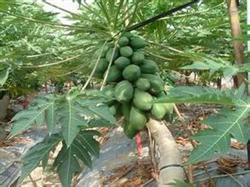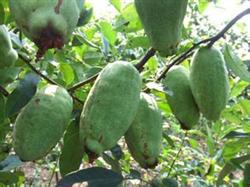Cultivation techniques for high yield of papaya

Papaya belongs to the genus Chaenomeles of Rosaceae. It is an ancient local variety in Linyi. Its fruit is rich in nutrition and has high medicinal value. In 2003, Caozhuang Town introduced 1000 mu of papaya, mainly Luo Fu and Changjun. At present, the growth is good. The main points of cultivation techniques of high-yield papaya in field are introduced as follows: 1 planting papaya is suitable for close planting, mountain and hilly land, plant row spacing is generally 1.5-2 m × 3 m, flat land with good fertilizer and water, plant row spacing is 2-3 m × 4-5 m, and when intercropping with grain and vegetables, plant row spacing is 3-5 m × 5-6 m. Papaya can be planted in spring or autumn. After planting, it can be dried at 70-80 cm on the ground. When sprouting, the sprouts within 50 cm of the root tiller and the base of the trunk should be wiped out in time, and the overdense shoots should be properly removed. (2) the soil, fertilizer and water management of papaya has strong adaptability, the opposite soil requirements are not strict, resistant to barren, more tolerant to salt and alkali, not resistant to waterlogging. The base fertilizer of papaya orchard is mostly applied in autumn, and the amount of base fertilizer accounts for about 70% of the total amount applied in the whole year. Topdressing should be carried out in the period of maximum fertilizer effect according to the growth and fruit of papaya trees. In the full fruit period, the tree should apply pre-flowering fertilizer, post-anthesis fertilizer and fruit expansion fertilizer in time, and the pre-flowering plant should apply 0.2-0.3 kg of fruit tree special fertilizer. In peacetime, 0.2% urea and 0.2% potassium dihydrogen phosphate should be sprayed in combination with pest control, and phosphate and potassium fertilizer should be applied mainly in the fruit expansion period. When base fertilizer was applied in autumn, 10-15 kg organic fertilizer per fruit tree was applied, and 0.5-1.0 kg ternary compound fertilizer was mixed. Irrigate once after fertilization and pay attention to water control at flowering stage. After planting in arid areas, the tree plate should be covered with plastic film or grass to preserve soil moisture. 3 Flower and fruit management papaya self-pollination has high seed setting rate and easy fruit setting. Releasing bees or artificial pollination at flowering stage can increase fruit setting rate. Papaya fruit has the phenomenon of self-thinning, poor pollination of the fruit will automatically fall off, therefore, after setting fruit in the first ten days of May every year, only small fruit, abnormal fruit can be. 4 after shaping and pruning, the middle stem of the papaya tree is relatively erect, and after a little pruning, it can be shaped into a cup-shaped, cylindrical or slender spindle shape, with a height of 2.1-2.3 meters, a crown diameter of 1.2-1.8 meters, and a stem height of 0.5-0.6 meters. There are 8-12 staggered main branches on the trunk, and the distance between the adjacent main branches is 20-30 cm. There are 1-3 fruiting branch groups on each main branch. The main branch should be released slowly to promote the growth of medium and short branches. Pruning is mainly sparse, and attention should be paid to cutting off competitive branches in the middle stem, long branches in the crown, over-dense branches, thin and weak branches, disease and insect branches and so on. The branch deficiency site can leave 1-2 buds truncated to promote branching, and the senescent fruiting branch group should be retracted and renewed in time. (5) the main diseases and insect pests of papaya are: leaf spot disease and ring disease. Anthracnose, dry rot, aphids, red spiders, papaya borer, peach heart borer, pear planthopper, diamondback moth, etc. control methods: spraying imidacloprid EC 3000 times in early March, spraying 30% peach Xiaoling EC 500times and 50% carbendazim wettable powder mixture in late May to early June and early July respectively to control papaya borer, diamondback moth, peach heart borer and leaf spot, etc., from late July to before defoliation At intervals of 20-25 days, 70% mancozeb 800 times solution, 50% carbendazim wettable powder 600-800 times solution, equal volume Bordeaux solution and other fungicides were sprayed alternately for 3 times and 4 times. At the same time, pay attention to the control of all kinds of caterpillars, pear planthoppers and other pests, clean up the orchard after winter, sweep away fallen leaves, stiff fruits, disease and insect branches, and concentrate on burning.
- Prev

Control of brown rot of papaya
Generally multi-row ground planting, but you can also make pile scenery to implement potted plants. The suitable planting period is before sprouting in early spring or after defoliation in early winter. When the seedling comes out of the nursery, keeping the intact root system of the seedling is one of the keys to the survival of planting. Generally, large seedlings should be planted with soil balls, and small seedlings should stay in the lodging soil according to the situation. The seedlings should be added after planting.
- Next

The cultivation of papaya
Planting and cultivation 1. Land selection and soil preparation shall be carried out in places with sufficient sunshine, fertile soil, moist soil and good drainage for planting. It can also be planted in the corner of the field, hillside land and in front of and behind the house. When planting in pieces, holes shall be opened according to the row spacing of 1 m ×2 m, and 5~10 kg of farm manure and soil shall be mixed into each hole as base fertilizer. Nursery ground...
Related
- Moge, come on! The staff of the peasant association in the producing area of cantaloupe were frightened when the crowd gathered.
- Causes and Solutions of low Fruit setting rate of Apple
- Symptoms and control measures of passion fruit virus disease
- Fruit growing lesson: how do apple orchards keep high yields?
- Can you build orchards in the mountains? What are the pros and cons?
- How to manage the coloring period of Crisson grape?
- This paper introduces the processing technology of two kinds of fig products.
- How much is a month for retired teachers in rural areas by 2020?
- How can strawberry planting increase sugar content? We should pay attention to management in many aspects.
- What are the cultivation techniques on how to improve the yield of golden fruit?

